JEE Main Physics Question Paper with Solution 2023 January 24th Shift 2 - Evening
A
-1
B
2
C
3
D
1
Solution
$ \vec{P} \cdot \vec{Q}=0 $
$(\hat{i}+2 m \hat{j}+m \hat{k}) \cdot(4 \hat{i}-2 \hat{j}+m \hat{k})-0 $
$ \Rightarrow 4-4 m+m^2=0 $
$ \Rightarrow(m-2)^2=0 \Rightarrow m=2$
A
$\frac{21}{25}$
B
$\frac{25}{21}$
C
$\frac{35}{27}$
D
$\frac{27}{35}$
Solution
For monoatomic gas $\gamma_1=\frac{5}{3}$
For diatomic gas at low temperatures
$\gamma_2=\frac{7}{5} $
$ \therefore \frac{\gamma_1}{\gamma_2}=\frac{\frac{5}{3}}{\frac{7}{5}}=\frac{25}{21}$
A
Statement I is correct but statement II is incorrect
B
Both Statement I and Statement II are incorrect
C
Both Statement I and II are correct
D
Statement I is incorrect but statement II is correct
Solution
$g ^{\prime}=\frac{ g }{\left(1+\frac{ h }{ R }\right)^2} $
$g ^{\prime}= g \left\{1-\frac{ d }{ R }\right\}$

Statement I is correct & Statement II is incorrect
A
$\frac{2 \lambda}{\epsilon_0}$
B
$\frac{\lambda}{2 \epsilon_0}$
C
$\frac{\lambda}{4 \epsilon_0}$
D
$\frac{\lambda}{\epsilon_0}$
Solution
Potential at centre
$ V=\frac{\left(\lambda \cdot \pi R_2\right)}{4 \pi \varepsilon_0 R_2}+\frac{\left(\lambda \cdot \pi R_1\right)}{4 \pi \varepsilon_0 R_1} $
$=\frac{\lambda}{2 \varepsilon_0}$
A
A-II, B-III, C-I, D-IV
B
A-II, B-I, C-IV, D-III
C
A-IV, B-III, C-I, D-II
D
A-I, B-III, C-II, D-IV
Solution
AM Broadast $\rightarrow 540-1600\, KHz$
FM Broadcast $\rightarrow 88-108\, MHz$
Television $\rightarrow 54-890 \,MHz$
Salellite communication $\rightarrow 3.7-4.2\, GHz$
$\therefore$ A-II, B-I, C-IV, D-III
A
$1: 1$
B
$2: 3$
C
$2:5$
D
$1: 2$
Solution

$ kx = m \left( L _0+ x \right) \omega^2$
$ \Rightarrow 12.5 x =\frac{1}{5}\left( L _0+ x \right) 25 \Rightarrow 1.5 x = L _0 $
$ \Rightarrow \frac{ x }{ L _0}=\frac{2}{3}$
A
Scattering
B
Chromatic aberration
C
Spherical aberration
D
Polarisation
Solution
Based on fact.
A
$941\, nm$
B
$974 \,nm$
C
$99.3\, nm$
D
$94.1 \,nm$
Solution
$\frac{ hc }{\lambda}=\left[1-\frac{1}{16}\right](13.6\, eV )$
So, $\lambda=94.1 \,nm$
A
$1: 2 $
B
$1: 4$
C
$1: 3$
D
$1: 1$
Solution
Displacement $=\Sigma$ area $=16-8+16-8=16\, m$
Distance $=\Sigma \mid$ area $\mid=48\, m$
$\frac{\text { displacement }}{\text { Distance }}=\frac{1}{3}$
A
$88 \times 10^{-4} T$
B
$1232 \times 10^{-4} T$
C
$352 \times 10^{-4} T$
D
$176 \times 10^{-4} T$
Solution
$ B =\mu_0 nI $
$ =4 \pi \times 10^{-7} \times 70 \times 10^2 \times 2$
$ =56 \pi \times 10^{-4} T $
$ =176 \times 10^{-4} T$
A
Both A and R are correct but R is NOT the correct explanation of A
B
Both A and R are correct and R is the correct explanation of A
C
A is not correct but R is correct
D
A is correct but R is not correct
Solution
Concept based
A
$\left(-\frac{3}{2}, \frac{1}{2}, \frac{1}{2}\right)$
B
$\left(-\frac{3}{2},-\frac{1}{2}, \frac{1}{2}\right)$
C
$\left(\frac{3}{2}, \frac{1}{2},-\frac{1}{2}\right)$
D
$\left(\frac{3}{2},-\frac{1}{2}, \frac{1}{2}\right)$
Solution
$ {\left[ T ^{-1}\right]=\left[ L ^1\right]^{ a }\left[ M ^1 L ^{-3}\right]^{ b }\left[\frac{ MLT ^{-2}}{ L }\right]^{ c }}$
$ \Rightarrow T ^{-1}= M ^{ b + c } \cdot L ^{ a -3 b } \cdot T ^{-2 c }$
$ c =\frac{1}{2}, b =-\frac{1}{2}, a -3 b =0$
$a +\frac{3}{2}=0 \Rightarrow a =-\frac{3}{2}$
A
$E_0 B_0=\omega k$
B
$E _0= kB _{ 0}$
C
$kE _{ 0 }=\omega B _{ 0 }$
D
$\omega E _{ 0 }= kB _{ 0 }$
Solution
$C =\frac{\omega}{ k }=\frac{ E _0}{ B _0}$
A
$45 \, V$
B
$40 \, V$
C
$80 \, V$
D
$90\, V$
Solution

$ R _{\text {eq }}=\frac{400 \times 100}{500}+100$
$ =180 \Omega $
$ i =\frac{90}{180}=\frac{1}{2} A$
Reading $=\frac{1}{2} \times \frac{400}{500} \times 100 $
$ =40 \text { volt }$
A
$ \frac{1}{2} B ^2 L ^2 \omega $
B
$ \frac{1}{4} BL ^2 \omega$
C
$\frac{1}{2} BL ^2 \omega $
D
$ \frac{1}{4} B ^2 L \omega$
Solution

$ \int d \varepsilon=\int B(\omega x) d x $
$ \varepsilon=B \omega \int\limits_0^L x d x=\frac{B \omega L^2}{2}$
A
Both A and R are correct but R is NOT the correct explanation of A
B
Both A and R are correct and R is the correct explanation of A
C
A is not correct but R is correct
D
A is correct but R is not correct
Solution
$T \propto \frac{1}{\sqrt{ g }}$
A
$6 \times 10^6 km$
B
$3 \times 10^6 km$
C
$6 \times 10^7 km$
D
$3 \times 10^7 km$
Solution
$ T ^2 \propto R ^3 \Rightarrow\left(\frac{ T _1}{ T _2}\right)^2=\left(\frac{ R _1}{ R _2}\right)^3 $
$ \Rightarrow\left(\frac{1}{2.83}\right)^2=\left(\frac{1.5 \times 10^6}{ R _2}\right)^3 $
$ \Rightarrow R _2=\left[(2.83)^2 \times\left(1.5 \times 10^6\right)^3\right]^{1 / 3} $
$ =8^{1 / 3} \times 1.5 \times 10^6=3 \times 10^6 km $
A

B
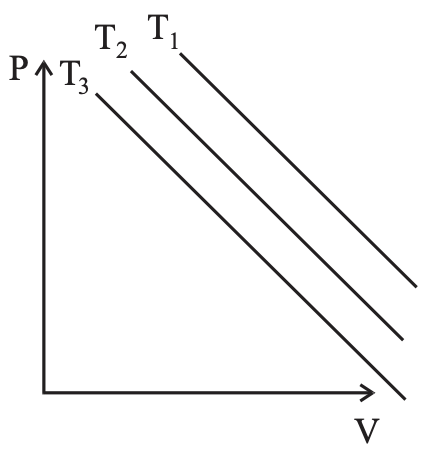
C
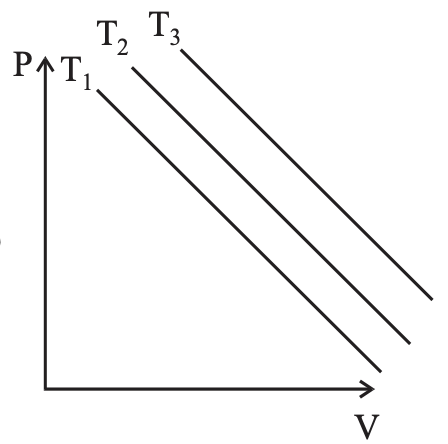
D
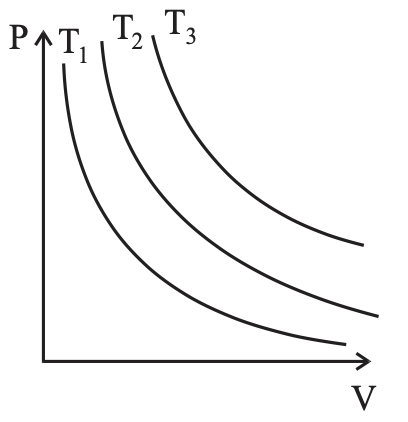
Solution
For isothermal process P-V graph is rectangular hyperbola

As dotted line is isobaric line which implies $T _3> T _2> T _1$ as volume is increasing.
A
$\lambda_\alpha>\lambda_p>\lambda_e$
B
$\lambda_\alpha<\lambda_p<\lambda_e$
C
$\lambda_\alpha=\lambda_p=\lambda_e$
D
$\lambda_\alpha>\lambda_p<\lambda_e$
Solution
$ \lambda_{ D }=\frac{ h }{ p }=\frac{ h }{\sqrt{2 mK }} $
$\therefore \lambda \propto \frac{1}{\sqrt{ m }} $
$ \because m _\alpha> m _{ p }> m _{ e }$
$ \lambda_{ c }>\lambda_{ p }>\lambda_\alpha$
Answer: 44
Solution
As volume is constant,
So resistance $\propto$ (length $)^2$
$\Rightarrow \% \text { change in resistance }=20+20+\frac{400}{100}=44 \%$
Answer: 3
Solution
After long time an inductor behaves as a resistance-less path.
So current through cell
$I =\frac{12}{ R / 3}=3 A \{\because R =12\, \Omega\}$
Answer: 7
Solution
When the ball attain terminal velocity
$ F _{ v }=\left( mg - F _{ B }\right)(\because a =0) $
$ =\operatorname{V} \sigma_{ b } g - V \rho_{\ell} g $
$=\operatorname{Vg}\left(\sigma_{ b }-\rho_{\ell}\right) $
$=\frac{4}{3} \pi\left(10^{-3}\right)^3 \times 9.8(10.5-1.5) \times 10^3$
$ =3696 \times 10^{-7} N $
So , $x =7$
Answer: 100
Solution
$ \vec{ F }=t \hat{ i }+3 t ^2 \hat{ j } $
$ \frac{ md \vec{ v }}{ dt }=t \hat{ i }+3 t ^2 \hat{ j } $
$ m =1 \,kg , \int\limits_0^{\vec{v}} dv =\int\limits_0^{ t } tdt \hat{ i }+\int\limits_0^{ t } 3 t ^2 dt \hat{ j } $
$ \vec{ v }=\frac{ t ^2}{2} \hat{ i }+ t ^3 \hat{ j } $
Power $=\vec{ F } \cdot \vec{ V }=\frac{ t ^3}{2}+3 t ^5$
At $ t =2$, power $=\frac{8}{2}+3 \times 32$
$ =100$
Answer: 1
Solution
$ T =2 \pi \sqrt{\frac{ m }{ k }}=1$
$T ^{\prime}=2 \pi \sqrt{\frac{ m +3}{ k }}=2 $
$ \frac{ T }{ T ^{\prime}}=\sqrt{\frac{ m }{ m +3}}=\frac{1}{2}$
$ \Rightarrow \frac{ m }{ m +3}=\frac{1}{4} $
$ m =1$
Answer: 6
Solution
No. of mole $=\frac{120}{240}=\frac{1}{2}$
No. of molecules $-\frac{1}{2} \times N _{ A }$
Energy released $=\frac{1}{2} \times 6 \times 10^{23} \times 200$
$=6 \times 10^{25} MeV$
Answer: 32
Solution

$ I_1=\frac{m_1 R^2}{2} I_2=\frac{m_2(R / 2)^2}{2}$
$ \frac{I_1}{I_2}=\frac{4 m _1}{m_2}=\frac{4 \cdot \rho \pi R^2 \ell}{\rho \cdot \frac{\pi R^2}{4} \times \frac{\ell}{2}} \Rightarrow \frac{I_1}{I_2}=32$
Answer: 9
Solution

Force on $5\, cm$ side is
$ |\vec{F}|=\text { ILB } \sin \theta $
$=(2)\left(5 \times 10^{-2}\right) \times \frac{3}{4} \times \frac{12}{13}=\frac{9}{130} N$
So, $x=9$
Answer: 105
Solution
$ C _0=\frac{\in_0 A }{ d }=15 pF $
$ C =\frac{ K \in_0 A }{2 d }=\frac{3.5}{2} \times 15 pF =\frac{105}{4} pF $
Answer: 54
Solution
$ \frac{ I }{ f _{ H _2 O }}=\left(\frac{\mu_{ g }}{\mu_{ H _2 O }}-1\right)\left(\frac{2}{ R }\right) $
$ =\frac{1}{8}\left(\frac{2}{ R }\right) $
$ =\frac{1}{\left(4 f _{ air }\right)}$
So, $f _{ H _2 O }=4 f _{\text {air }}=72\, cm$
So change in focal length $=72-18=54 \,cm$
JEE Main Chemistry Question Paper with Solution 2023 January 24th Shift 2 - Evening
A
$0,1,2,1$
B
$2,1,2,1$
C
$0,1,0,1$
D
$2,1,0,1$
Solution
$N _2$
$\sigma 1 s ^2 \sigma^* 1 s ^2 \sigma 2 s ^2 \sigma^* 2 s ^2 \pi 2 p _{ x }^2=\pi 2 p _{ y }^2 \frac{\sigma 2 p _{ z }^2}{ HOMO }$
$N _2^{+}-\sigma 1 s ^2 \sigma^* 1 s ^2 \sigma^* 2 s ^2 \sigma^* 2 s ^2 \pi 2 p _{ x }^2=\pi 2 p _{ y }^2 \frac{\sigma 2 p _{ z }^1}{ HOMO }$
$O _2-\sigma 1s ^2 \sigma^* 1 s ^2 \sigma 2 s ^2 \sigma^* 2 s ^2 \sigma 2 p _{ z }^2 $
$\pi 2 p _{ x }^2=\pi 2 p _{ y }^2$
$\pi^* 2 p _{ x }^1=\pi^* 2 p _{ y }^1( HOMO )$
$O _2^{+}-\sigma 1 s ^2 \sigma^* 1s ^2 \sigma 2 s ^2 \sigma ^* 2 s ^2 \sigma 2 p _{ z }^2 \pi 2 p _{ x }^2=\pi 2 p _{ y }^2 $
$\pi^* 2 p _{ x }^1=\pi^* 2 p _{ y }^0( HOMO )$
$ N _2 \Rightarrow 0$ unpaired $ e ^{-} \text {in HOMO }$
$ N _2^{+} \Rightarrow 1 $ unpaired $ e ^{-} \text {in HOMO } $
$ O _2 \Rightarrow 2 $ unpaired $ e ^{-} \text {in HOMO } $
$ O _2^{+} \Rightarrow 1 $ unpaired $e ^{-} \text {in HOMO }$
A
A is false but $R$ is true
B
Both $A$ and $R$ are correct but $R$ is NOT the correct explanation of $A$
C
$A$ is true but $R$ is false
D
Both $A$ and $R$ are correct and $R$ is the correct explanation of $A$
Solution
Assertion - A : Benzene is more stable than cyclohexatriene (True)
Reason - R : Delocalised $\pi-$ e cloud lies B.M.O so more attracted by nuclei of carbon atom.
(True & Correct Explanation)
A
D only
B
C and D only
C
C only
D
A and B only
Solution
$Ce ^{+4}$ and $Tb ^{+4}$ act as oxidising agent.
A
Both a and c
B
a only
C
b only
D
c only

A
$PbS +4 H _2 O _2 \rightarrow PbSO _4+4 H _2 O$
B
$2 Fe ^{2+}+ H _2 O _2 \rightarrow 2 Fe ^{3+}+2 OH ^{-}$
C
$HOCl + H _2 O _2 \rightarrow H _3 O ^{+}+ Cl ^{-}+ O _2$
D
$Mn ^{2+}+ H _2 O _2 \rightarrow Mn ^{4+}+2 OH ^{-}$
A
8
B
12
C
9
D
10
Solution
$Z =55[ Cs ] \Rightarrow[ Xe ] 6 s ^1$
$\left[ Cs ^{+}\right] \Rightarrow[ Xe ]$ i.e. upto $5 s$ count $e ^{-}$of s-subshell
i.e. $1 s , 2 s , 3 s , 4 s , 5 s \Rightarrow 10$ electrons
A
Magnetic properties of transition metal complexes
B
The order of spectrochemical series
C
Colour of metal complexes
D
Stability of metal complexes
Solution
Crystal field theory introduce spectrochemical series based upon the experimental values of $\triangle$ but can't explain it's order. While other three points are explained by CFT. Specially when the CFSE increases thermodynamic stability of the complex increases.
A
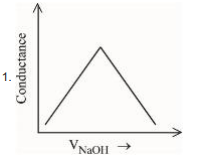
B
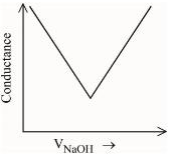
C

D
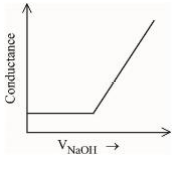
Solution

(A) $\rightarrow$ (B) Free $H ^{+}$ions are replaced by $Na ^{\oplus}$ which decreases conductance.
(B) $\rightarrow$ (C) Un-dissociated benzoic acid reacts with $NaOH$ and forms salt which increases ions & conductance increases.
(C) $\rightarrow$ (D) After equivalence point at (3), $NaOH$ added further increases $Na ^{\oplus} \& OH ^{\odot}$ ions which further increases the conductance.
A
C and E only
B
A and E only
C
A, B, D only
D
A, B and E only
Solution
(1) $Na > Cs > Li -$ true $\{$ If considered with sign $\}$ The low solubility of CsI is due to smaller hydration enthalpy of it's two ions $Li _2 CO _3$ is highly stable to heat - false In Conc. $NH _3, K$ formed blue solution - true All the alkali metal hydrides are ionic solid (True).
A
1
B
$0.5$
C
0 (zero)
D
2
Solution
$ t _{1 / 2} \propto\left( P _{ O }\right)^{1- n }$
$ \frac{\left( t _{1 / 2}\right)_1}{\left( t _{1 / 2}\right)_2}=\frac{\left( P _0\right)_1^{1- n }}{\left( P _{0_2}\right)_2^{1- n }} $
$\Rightarrow\left(\frac{4}{2}\right)-\left(\frac{50}{100}\right)^{1- n } $
$ \Rightarrow 2=\left(\frac{1}{2}\right)^{1- n } $
$ \Rightarrow 2=(2)^{ n -1} $
$ \Rightarrow n -1=1$
$n =2$
A
A-I, B-III, C-II, D-IV
B
A-II, B-I, C-III, D-IV
C
A-IV, B-III, C-II, D-I
D
A-I, B-II, C-III, D-IV
Solution
Theoretical, NCERT based
A
An average human being consumes equal amount of food and air
B
An average human being consumes more food than air
C
An average human being consumes nearly 15 times more air than food
D
An average human being consumes 100 times more air than food
Solution
Theoretical.
A
Blue
B
White
C
Red
D
Yellow

A
Statement I is true but Statement II is false
B
Statement I is false but Statement II is true
C
Both Statement I and Statement II are true
D
Both Statement I and Statement II are false
A
Both $A$ and $R$ are correct and $R$ is the correct explanation of $A$
B
$A$ is not correct but $R$ is correct
C
Both $A$ and $R$ are correct but $R$ is NOT the correct explanation of $A$
D
$A$ is correct but $R$ is not correct
Solution
$Be$ has less negative value compared to other AEM. However it's reducing nature is due to large hydration energy associated with the small size of $Be ^{2+}$ ion and relatively large value of the atomization enthalpy of metal.
A
$sp ^3 d ^2$ and paramagnetic
B
$d ^2 sp ^3$ and paramagnetic
C
$d ^2 sp ^3$ and diamagnetic
D
$sp ^3 d ^2$ and diamagnetic
Solution
$\left[ Co \left( NH _3\right)_6\right]^{+3}- d ^2 sp ^3$, diamagnetic
A
Both Statement I and Statement II are correct
B
Statement I is incorrect but Statement II is correct
C
Both Statement I and Statement II are incorrect
D
Statement I is correct but Statement II is incorrect
Solution
Statement $-1$ is (True)
Pure aniline is colourless liquid
Statement - 2 is (False)
Aniline becomes dark brown due to action of air and light [oxidation]
A
Hydrogen sulphide
B
Sulphur dioxide
C
Carbon dioxide
D
Sulphur trioxide
Solution
$3 SO _2+ Cr _2 O _7^{2-}+2 H ^{+} \rightarrow 3 SO _4^{2-}+\underset{\text{green}}{2 Cr ^{+3}}+ H _2 O$
A
$Al$
B
$Cu$
C
$Ag$
D
$Fe$
Solution
$Ag$.
$4 Ag +8 CN ^{-}+ O _2+2 H _2 O \rightarrow 4\left[ Ag ( CN )_2\right]^{-}+4 OH ^{-} $
$ 2\left[ Ag ( CN )_2\right]^{-1}+ Zn \rightarrow 2 Ag \downarrow+\left[ Zn ( CN )_4\right]^{-2}$
Answer: 2
Solution
For physisorptions
(a)Decreases with increase in temperature
(b)No appreciable activation energy is required
Answer: 314
Solution
Let V.P. of pure $A$ be $P _{ A }^0$
Let V.P of pure $B$ be $P_B^0$
When $X _{ A }=0.7 \& X _{ B }=0.3$
$ P _{ s }=350$
$ \Rightarrow P _{ A }^0 \times 0.7+ P _{ B }^0 \times 0.3=350 ....$(i)
When $X _{ A }=0.2 \& X _{ B }=0.8$
$P _{ s }=410$
$ \Rightarrow P _{ A }^0 \times 0.2+ P _{ B }^0 \times 0.8=410,......$(ii)
Solving (i) and (ii)
$ P _{ A }^0=314 \,mm \,Hg $
$P _{ B }^0=434\, mm \,Hg $
$ =(314)$
Answer: 8
Solution

No, of $\pi-$ bonds $=4$
Total $\pi-$ bonds $=8$
Answer: 5
Solution
Mass percent, mole fraction, molarity, ppm, molality are used for measuring concentration terms.
Answer: 2
Solution
The spectrum of Black body radiation is explained using quantization of energy. With increase in temperature, peak of spectrum shifts to shorter wavelength or higher frequency. For above graph $\rightarrow T _1> T _2> T _3> T _4$
Answer: 2
Solution

At
(a) $\rightarrow CO _2$ exist as gas
(b) $\rightarrow$ liquefaction of $CO _2$ starts
(c) $\rightarrow$ liquefaction ends
(d) $\rightarrow CO _2$ exist as liquid.
Between (b) & (c) $\rightarrow$ liquid and gaseous $CO _2$ co-exist.
As volume changes from (b) to (c) gas decreases and liquid increases.
(A), (C) $\rightarrow$ correct
Answer: 620
Solution
$ 1 \rightarrow 2 \Rightarrow $ Isobaric process
$ 2 \rightarrow 3 \Rightarrow $ Isochoric process
$ 3 \rightarrow 1 \Rightarrow $ Isothermal process
$W = W _{1 \rightarrow 2}+ W _{2 \rightarrow 3}+ W _{3 \rightarrow 1}$
$ =\left(- P \left( V _2- V _1\right)+0\left[- P _1 V _1 \ln \left(\frac{ V _2}{ V _1}\right)\right]\right) $
$ =\left[-1 \times(40-20)+0+\left[-1 \times 20 \ln \left(\frac{20}{40}\right)\right]\right] $
$ =-20+20 \ln 2$
$ =-20+20 \times 2.3 \times 0.3 $
$ =-6.2 \text { bar } L$
$| W |=6.2 \text { bar } 1=620\, J $
Answer: 3
Solution

Total numbers of isomer $= 03$
Answer: 8
Solution
No. of possible tripeptide :
Val & Pro is $2^3$
(1) val - val - val
(2)pro - pro - pro
(3) val - pro - pro
(4) pro - val - pro
(5) val - val - pro
(6) val - pro - val
(7)pro - pro - val
(8)pro - val - val
Answer: 85
Solution
Concentration of calcium lactate $=0.005 \,M$,: concentration of lactate ion $=(2 \times 0.005)\, M$. Calcium lactate is a salt of weak acid $+$ strong base $\therefore$ Salt hydrolysis will take place.
$ pH =7+\frac{1}{2}( pKa +\log C ) $
$ =7+\frac{1}{2}(5+\log (2 \times 0.005))$
$ =7+\frac{1}{2}[5-2 \log 10]=7+\frac{1}{2} \times 3=8.5=85 \times 10^{-1}$
JEE Main Mathematics Question Paper with Solution 2023 January 24th Shift 2 - Evening
A
$-1$
B
1
C
3
D
5
Solution
Direction ratio of line $= \begin{vmatrix} \hat{ i } & \hat{ j } & \hat{ k } \\ 1 & 2 & 1 \\ 0 & 3 & -1\end{vmatrix} $
$ =\hat{ i }(-5)-\hat{ j }(-1)+\hat{ k }(3) $
$ =-5 \hat{ i }+\hat{ j }+3 \hat{ k }$

$ M (-5 \lambda+3, \lambda+2,3 \lambda+1) $
$ \overrightarrow{\operatorname{PM}} \perp(-5 \hat{ i }+\hat{ j }+3 \hat{ k }) $
$ -5(-5 \lambda+2)+(\lambda-7)+3(3 \lambda-6)=0 $
$ \Rightarrow 25 \lambda+\lambda+9 \lambda-10-7-18=0 $
$ \Rightarrow \lambda=1 $
Point $ M =(-2,3,4)=(\alpha, \beta, \gamma)$
$\alpha+\beta+\gamma=5$
A
4
B
3
C
2
D
0
Solution
$3\left(x^2+\frac{1}{x^2}\right)-2\left(x+\frac{1}{x}\right)+5=0$
$ 3\left[\left(x+\frac{1}{x}\right)^2-2\right]-2\left(x+\frac{1}{x}\right)+5=0$
Let $x +\frac{1}{ x }= t$
$ 3 t^2-2 t-1=0 $
$ 3 t^2-3 t+t-1=0$
$ 3 t(t-1)+1(t-1)=0 $
$( t -1)(3 t +1)=0 $
$ t =1,-\frac{1}{3}$
$ x +\frac{1}{ x }=1,-\frac{1}{3} \Rightarrow $ No solution.
A
9
B
11
C
7
D
6
Solution
Let $\vec{\beta}_1=\lambda \vec{\alpha}$
Now $\vec{\beta}_2=\vec{\beta}-\vec{\beta}_1$
$=(\hat{i}+2 \hat{ j }-4 \hat{ k })-\lambda(4 \hat{ i }+3 \hat{ j }+5 \hat{ k })$
$=(1-4 \lambda) \hat{ i }+(2-3 \lambda) \hat{ j }-(5 \lambda+4) \hat{ k }$
$ \vec{\beta}_2 \cdot \vec{\alpha}=0$
$\Rightarrow 4(1-4 \lambda)+3(2-3 \lambda)-5(5 \lambda+4)=0 $
$ \Rightarrow 4-16 \alpha+6-9 \lambda-25 \lambda-20=0$
$ \Rightarrow 50 \lambda=-10$
$\Rightarrow \lambda=\frac{-1}{5}$
$ \vec{\beta}_2=\left(1+\frac{4}{5}\right) \hat{ i }+\left(2+\frac{3}{5}\right) \hat{ j }-(-1+4) \hat{ k } $
$ \vec{\beta}_2=\frac{9}{5} \hat{ i }+\frac{13}{5} \hat{ j }-3 \hat{ k }$
$ 5 \vec{\beta}_2=9 \hat{ i }+13 \hat{ j }-15 \hat{ k }$
$5 \vec{\beta}_2 \cdot(\hat{ i }+\hat{ j }+\hat{ k })=9+13-15=7$
A
1011
B
2010
C
1010
D
2011
Solution
$f(x)=\frac{4^x}{4^x+2} $
$f(x)+f(1-x)=\frac{4^x}{4^x+2}+\frac{4^{1-x}}{4^{1-x}+2} $
$ =\frac{4^x}{4^x+2}+\frac{4}{4+2\left(4^x\right)}$
$ =\frac{4^x}{4^x+2}+\frac{2}{2+4^x}$
$ =1 $
$ \Rightarrow f(x)+f(1-x)=1$
Now $ f \left(\frac{1}{2023}\right)+ f \left(\frac{2}{2023}\right)+ f \left(\frac{3}{2023}\right)+\ldots \ldots+ $
$ \ldots \ldots \ldots+ f \left(1-\frac{3}{2023}\right)+ f \left(1-\frac{2}{2023}\right)+ f \left(1-\frac{1}{2023}\right)$
Now sum of terms equidistant from beginning and end is $1$
Sum $=1+1+1+\ldots \ldots \ldots .+1(1011$ times $)$
$=1011$
A
$-\frac{1}{2}(1-i \sqrt{3})$
B
$\frac{1}{2}(\sqrt{3}+i)$
C
$-\frac{1}{2}(\sqrt{3}-i)$
D
$\frac{1}{2}(1-i \sqrt{3})$
Solution
Let $\sin \frac{2 \pi}{9}+ i \cos \frac{2 \pi}{9}= z$
$ \left(\frac{1+ z }{1+\bar{z}}\right)^3=\left(\frac{1+ z }{1+\frac{1}{ z }}\right)^3= z ^3 $
$ \Rightarrow\left( i \left(\cos \frac{2 \pi}{9}- i \sin \frac{2 \pi}{9}\right)\right)^3$
$ =-i\left(\cos \frac{2 \pi}{3}- i \sin \frac{2 \pi}{3}\right)=-i\left(\frac{-1}{2}- i \frac{\sqrt{3}}{2}\right) $
$ \Rightarrow \frac{-1}{2}(\sqrt{3}-i) .$
A
$2 \pi$
B
$\frac{\pi}{6}$
C
$\frac{\pi}{3}$
D
$\frac{\pi}{2}$
Solution
$\int\limits_{\frac{3 \sqrt{2}}{4}}^{\frac{3 \sqrt{3}}{4}} \frac{48}{\sqrt{9-4 x^2}} d x$
We have $\int \frac{d x}{\sqrt{a^2-x^2}}=\sin ^{-1} \frac{x}{a}+C$
Hence $\int\limits_{\frac{3 \sqrt{2}}{4}}^{\frac{3 \sqrt{3}}{4}} \frac{48}{\sqrt{9-4 x^2}} dx =\frac{48}{2} \times\left[\sin ^{-1} \frac{2 x}{3}\right]_{\frac{3 \sqrt{2}}{4}}^{\frac{3 \sqrt{3}}{4}}$
$=24 \times\left[\sin ^{-1}\left(\frac{2}{3} \times \frac{3 \sqrt{3}}{4}\right)-\sin ^{-1}\left(\frac{2}{3} \times \frac{3 \sqrt{2}}{4}\right)\right]$
$=24 \times\left[\sin ^{-1} \frac{\sqrt{3}}{2}-\sin ^{-1} \frac{1}{\sqrt{2}}\right]$
$ =24 \times\left(\frac{\pi}{3}-\frac{\pi}{4}\right)$
$ =24 \times \frac{\pi}{12}=2 \pi$
A
$e^2$
B
$\frac{3}{2} e^2$
C
$3 e^2$
D
$2 e ^2$
Solution
$ \left(x^2-3 y^2\right) d x+3 x y d y=0$
$\frac{d y}{d x}=\frac{3 y^2-x^2}{3 x y} \Rightarrow \frac{d y}{d x}=\frac{y}{x}-\frac{1}{3} \frac{x}{y}.....(1)$
Put $y=v x$
$\frac{d y}{d x}=v+x \frac{d v}{d x}$
(1) $\Rightarrow v+x \frac{d v}{d x}=v-\frac{1}{3} \frac{1}{v} $
$\Rightarrow v d v=\frac{-1}{3 x}$
Integrating both side
$ \frac{v^2}{2}=\frac{-1}{3} \ln x+c $
$\Rightarrow \frac{y^2}{2 x^2}=\frac{-1}{3} \ln x+c$
$ y(1)=1$
$\Rightarrow \frac{1}{2}=c$
$ \Rightarrow \frac{y^2}{2 x^2}=\frac{-1}{3} \ln x+\frac{1}{2} $
$ \Rightarrow y^2=-\frac{2}{3} x^2 \ln x+x^2$
$ y^2(e)=-\frac{2}{3} e^2+e^2=\frac{e^2}{3}$
$\Rightarrow 6 y ^2( e )=2 e ^2$
A
8
B
6
C
7
D
9
Solution
$ f ( x + y )= f ( x ) \cdot f ( y ) \forall x , y \in N , f (1)=3$
$ f (2)= f ^2(1)=3^2$
$ f (3)= f (1) f (2)=3^3$
$f (4)=3^4$
$f ( k )=3^{ k } $
$\displaystyle \sum_{ k =1}^{ n } f ( k )=3279$
$ f (1)+ f (2)+ f (3)+\ldots \ldots \ldots+ f ( k )=3279$
$ 3+3^2+3^3+\ldots \ldots \ldots 3^{ k }=3279$
$ \frac{3\left(3^{ k }-1\right)}{3-1}=3279 $
$ \frac{3^{ k }-1}{2}=1093$
$ 3^{ k }-1=2186 $
$ 3^{ k }=2187 $
$k =7$
A
$[-7.5,-6.5)$
B
$(-7.5,-6.5)$
C
$(-7.5,-6.5]$
D
$[-7.5,-6.5]$
Solution
$\displaystyle \lim _{x \rightarrow a}([x-5]-[2 x+2])=0$
$ \displaystyle\lim _{x \rightarrow a}([x]-5-[2 x]-2)=0$
$\displaystyle \lim _{x \rightarrow a}([x]-[2 x])=7 $
$ {[a]-[2 a]=7} $
$ a \in I, a=-7$
$ a \notin I, a=I+f $
Now, $[a]-[2 a]=7 $
$ -I-[2 f]=7$
Case-I: $ f \in\left(0, \frac{1}{2}\right)$
$ 2 f \in(0,1) $
$ - I =7 $
$ I =-7 \Rightarrow a \in(-7,-6.5) $
Case-II: $ f \in\left(\frac{1}{2}, 1\right)$
$ 2 f \in(1,2) $
$ - I -1=7$
$I =-8 \Rightarrow a \in(-7.5,-7)$
Hence, $a \in(-7.5,-6.5)$
A
$2 \sqrt{2}$
B
2
C
$\sqrt{6}$
D
4
Solution
$ AB :(\lambda+1) x +\lambda y =4$
$ AC : \lambda x +(1-\lambda) y +\lambda=0$
Vertex A is on $y$-axis
$\Rightarrow x=0$

So $y =\frac{4}{\lambda}, y =\frac{\lambda}{\lambda-1}$
$ \Rightarrow \frac{4}{\lambda}=\frac{\lambda}{\lambda-1} $
$ \Rightarrow \lambda=2$
$A B: 3 x+2 y=4$
$A C: 2 x-y+2=0$
$\Rightarrow A (0,2)$ Let $C (\alpha, 2 \alpha+2)$
Now (Slope of Altitude through C) $\left(-\frac{3}{2}\right)=-1$
$\left(\frac{2 \alpha}{\alpha-1}\right)\left(-\frac{3}{2}\right)=-1 \Rightarrow \alpha=-\frac{1}{2}$
So $C \left(-\frac{1}{2}, 1\right)$

Let Equation of tangent be $y = mx +\frac{3}{2 m }$
$ m^2+2 m-3=0 $
$ \Rightarrow m=1,-3$
So tangent which touches in first quadrant at $T$ is
$T \equiv\left(\frac{ a }{ m ^2}, \frac{2 a }{ m }\right) $
$ \equiv\left(\frac{3}{2}, 3\right)$
$ \Rightarrow CT =\sqrt{4+4}=2 \sqrt{2}$
A
$\frac{\pi}{2}$
B
$\frac{\pi}{4}$
C
$\frac{\pi}{6}$
D
$\frac{3 \pi}{4}$
Solution
In $\triangle CPB$

$ \cos \frac{\theta}{2}=\frac{P C}{2} \Rightarrow P C=2 \cos \frac{\theta}{2} $
$ \Rightarrow(h-4)^2+(k-5)^2=4 \cos ^2 \frac{\theta}{2} $
Now $(x-4)^2+(y-5)^2=\left(2 \cos \frac{\theta}{2}\right)^2$
$ \Rightarrow r_1=2 \cos \frac{\pi}{6}=\sqrt{3}$
$ r_2=2 \cos \frac{\theta_2}{2}$
$ r_3=2 \cos \frac{\pi}{3}=1 $
$ \Rightarrow r_1^2=r_2^2+r_3^2 $
$ \Rightarrow 3=4 \cos ^2 \frac{\theta_2}{2}+1 $
$ \Rightarrow 4 \cos ^2 \frac{\theta_2}{2}=2 $
$\Rightarrow \cos ^2 \frac{\theta_2}{2}=\frac{1}{2} $
$ \Rightarrow \theta_2=\frac{\pi}{2}$
Q12. Let $p$ and $q$ be two statements. Then $\sim(p \wedge(p \Rightarrow \sim q))$ is equivalent to
A
$p \vee(p \wedge q)$
B
$(\sim p) \vee q$
C
$p \vee(p \wedge(\sim q))$
D
$p \vee((\sim p) \wedge q)$
Solution
$ \sim( p \wedge( p \rightarrow \sim q )) $
$ \equiv \sim p \vee \sim(\sim p \vee \sim q ) $
$ \equiv \sim p \vee( p \wedge q ) $
$ \equiv(\sim p \vee p ) \wedge(\sim p \vee q ) $
$ \equiv t \wedge(\sim p \vee q ) $
$ \equiv \sim p \vee q $
A
$2 f(0)-f(1)+f(3)=f(2)$
B
$f(3)-f(2)=f(1)$
C
$3 f(1)+f(2)=f(3)$
D
$f(1)+f(2)+f(3)=f(0)$
Solution
$f(x)=x^3-x^2 f^{\prime}(1)+x f^{\prime \prime}(2)-f^{\prime \prime \prime}(3), x \in R$
Let $f ^{\prime}(1)= a , f ^{\prime \prime}(2)= b , f ^{\prime \prime \prime}(3)= c$
$f ( x )=x^3- a x ^2+ b x - c $
$ f ^{\prime}(x)=3 x^2-2 a x+b$
$ f^{\prime \prime}(x)=6 x-2 a$
$ f^{\prime \prime \prime}(x)=6$
$c=6, a=3, b=6$
$ f(x)=x^3-3 x^2+6 x-6$
$ f(1)=-2, f(2)=2, f(3)=12, f(0)=-6$
$2 f(0)-f(1)+f(3)=2=f(2)$
A
$5 \sqrt{6}$
B
$2 \sqrt{6}$
C
$3 \sqrt{6}$
D
$4 \sqrt{6}$
Solution
Equation of plane passing through point of intersection of $P 1$ and $P 2$
$ P=P 1+k P 2 $
$ (x+(\lambda+4) y+z-1)+k(2 x+y+z-2)=0$
Passing through $(0,1,0)$ and $(1,0,1)$
$ (\lambda+4-1)+ k (1-2)=0 $
$ (\lambda+3)- k =0 .....$(1)
Also passing $(1,0,1)$
$ (1+1-1)+ k (2+1-2)=0 $
$ 1+ k =0 $
$k =-1$
put in (1)
$ \lambda+3+1=0 $
$ \lambda=-4$
Then point $(2 \lambda, \lambda,-\lambda)$
$ d =\left|\frac{-16-4,-4,4)}{\sqrt{6}}\right| $
$ d =\frac{18}{\sqrt{6}} \times \frac{\sqrt{6}}{\sqrt{6}}=3 \sqrt{6}$
A
105
B
210
C
200
D
220
Solution
$ a_1+a_3=10=a_1+d \Rightarrow 5$
$ a _1+ a _2+a_3+ a _{ 4 }+ a _5+ a _6= 5 7 $
$ \Rightarrow \frac{6}{2}\left[a_1+a_6\right]=57 $
$ \Rightarrow a_1+a_6=19 $
$ \Rightarrow 2 a_1+5 d=19 \text { and } a_1+d=5$
$ \Rightarrow a_1=2, d=3$
Numbers : $2,5,8,11,14,17$
Variance $=\sigma^2=$ mean of squares-square of mean
$ =\frac{2^2+5^2+8^2+(11)^2+(14)^2+(17)^2}{6}-\left(\frac{19}{2}\right)^2$
$ =\frac{699}{6}-\frac{361}{4}=\frac{105}{4}$
$ 8 \sigma^2=210$
A
60
B
10
C
15
D
30
Solution
$S =0 \cdot\left({ }^{30} C _0\right)^2+1 \cdot\left({ }^{30} C _1\right)^2+2 \cdot \cdot\left({ }^{30} C _2\right)^2+\ldots \ldots+30 \cdot\left({ }^{30} C _{30}\right)^2 $
$S =30 .\left({ }^{30} C _0\right)^2+29 .\left({ }^{30} C _1\right)^2+28 .\left(^{30} C _2\right)^2+\ldots . .+0 .\left({ }^{30} C _0\right)^2$
$ 2 S =30 \cdot\left({ }^{30} C _0{ }^2++^{30} C _1^2+\ldots \ldots . \cdot{ }^{30} C _{30}{ }^2\right) $
$ S =15 \cdot{ }^{60} C _{30}=15 \cdot \frac{60 !}{(30 !)^2} $
$ \frac{15 \cdot 10 !}{(30 !)^2}=\frac{\alpha \cdot 60 !}{(30 !)^2}$
$\Rightarrow \alpha=15$
A
225
B
120
C
125
D
150
Solution

In each row and each column exactly one is to be placed -
$\therefore$ No. of such materials $=5 \times 4 \times 3 \times 2 \times 1=120$
Alternate :

Step-1 : Select any 1 place for 1 's in row 1. Automatically some column will get filled with 0 's.
Step-2 : From next now select 1 place for 1's. Automatically some column will get filled with 0 's. $\Rightarrow$ Each time one less place will be available for putting 1's.
Repeat step-2 till last row.
Req. ways $=5 \times 4 \times 3 \times 2 \times 1=120$
A
168
B
120
C
220
D
48
Solution
Four digit numbers greater than $7000$
$=2 \times 4 \times 3 \times 2=48$
Five digit number $=5 !=120$
Total number greater than $7000$
$=120+48=168$
A
1
B
$\sqrt{6}$
C
12
D
$2 \sqrt{3}$
Solution
Given $|\operatorname{adj}(\operatorname{adj}(\operatorname{adj} . A ))|=12^4$ $\Rightarrow| A |^{( n -1)^3}=12^4$
Given $n =3$
$\Rightarrow| A |^8=12^4 $
$\Rightarrow| A |^2=12$
$ | A |=2 \sqrt{3}$
We are asked
$ \left| A ^{-1} \cdot \operatorname{adj} A \right|$
$ =\left| A ^{-1}\right| \cdot|\operatorname{adj} A | $
$ =\frac{1}{| A |} \cdot| A |^{3-1} $
$ =| A |=2 \sqrt{3}$
A
$\left(\frac{72}{5},-\frac{21}{5}\right)$
B
$\left(\frac{72}{5}, \frac{21}{5}\right)$
C
$\left(-\frac{72}{5} \cdot-\frac{21}{5}\right)$
D
$\left(-\frac{72}{5}, \frac{21}{5}\right)$
Solution
$ x+2 y+3 z=3 ......$(i)
$ 4 x+3 y-4 z=4.......$(ii)
$ 8 x+4 y-\lambda z=9+\mu ......$(iii)
$ \text { (i) } \times 4 \text { - (ii) } \Rightarrow 5 y +16 z =8......$(iv)
(ii) $\times 2-$ (iii) $\Rightarrow 2 y+(\lambda-8) z=-1-\mu ......$(v)
(iv) $\times 2-$ (iii) $\times 5 \Rightarrow(32-5(\lambda-8)) z=16-5(-1-\mu)$
For infinite solutions $\Rightarrow 72-5 \lambda=0 \Rightarrow \lambda=\frac{72}{5}$
$21+5 \mu=0 \Rightarrow \mu=\frac{-21}{5}$
$\Rightarrow(\lambda, \mu) \equiv\left(\frac{72}{5}, \frac{-21}{5}\right)$
Answer: 27
Solution
$ f(x)+\int\limits_0^x f(t) \sqrt{1-\left(\log _e f(t)\right)^2} d t=e$
$ \Rightarrow f(0)=e$
$ f^{\prime}(x)+f(x) \sqrt{1-(\ln f(x))^2}=0 $
$ f(x)=y $
$ \frac{d y}{d x}=-y \sqrt{1-(\ln y)^2}$
$ \int \frac{d y}{y \sqrt{1-(\ln y)^2}}=-\int d x $
Put $\ln y=t $
$ \int \frac{d t}{\sqrt{1-t^2}}=-x+C$
$ \sin ^{-1} t=-x+C \Rightarrow \sin ^{-1}(\ln y)=-x+C$
$ \sin ^{-1}(\ln f(x))=-x+C $
$ f(0)=e $
$ \Rightarrow \frac{\pi}{2}=C$
$ \Rightarrow \sin ^{-1}(\ln f(x))=-x+\frac{\pi}{2} $
$ \Rightarrow \sin ^{-1}\left(\ln f\left(\frac{\pi}{6}\right)\right)=\frac{-\pi}{6}+\frac{\pi}{2} $
$ \Rightarrow \sin ^{-1}\left(\ln f\left(\frac{\pi}{6}\right)\right)=\frac{\pi}{3} $
$ \Rightarrow \ln f\left(\frac{\pi}{6}\right)=\frac{\sqrt{3}}{2}, $ we need $\left(6 \times \frac{\sqrt{3}}{2}\right)^2=27$
Answer: 36
Solution
$ y^2-2 y=-x $
$ \Rightarrow y^2-2 y+1=-x+1 $
$ (y-1)^2=-(x-1) $
$y=-x$
Points of intersection
$x^2+2 x=-x$
$ x^2+3 x=0 $
$ x=0,-3$

$ A=\int\limits_0^3\left(-y^2+2 y+y\right) d y$
$ =\frac{3 y^2}{2}-\left.\frac{y^3}{3}\right|_0 ^3=\frac{9}{2} $
$8 A=36$
Answer: 8
Solution
$ \vec{ a }=\hat{ i }+2 \hat{ j }+\lambda \hat{ k }, \vec{ b }=3 \hat{ i }-5 \hat{ j }-\lambda \hat{ k }, \vec{ a } \cdot \vec{ c }=7$
$ \vec{ a } \times \vec{ c }-\vec{ b } \times \vec{ c }=\vec{0}$
$ (\vec{ a }-\vec{ b }) \times \vec{ c }=0 \Rightarrow(\vec{ a }-\vec{ b }) \text { is paralleled to } \vec{ c }$
$ \vec{ a }-\vec{ b }=\mu \vec{ c } \text {, where } \mu \text { is a scalar } $
$ -2 \hat{ i }+7 \hat{ j }+2 \lambda \hat{ k }=\mu \cdot \overrightarrow{ c }$
Now $\vec{ a } \cdot \vec{ c }=7$ gives $2 \lambda^2+12=7 \mu$
And $\vec{b} \cdot \vec{c}=-\frac{43}{2}$ gives $4 \lambda^2+82=43 \mu$
$\mu=2$ and $\lambda^2=1$
$|\vec{ a } \cdot \vec{ b }|=8$
Answer: 13
Solution
Given $R=\{(a, b),(b, c),(b, d)\}$
In order to make it equivalence relation as per given set, $R$ must be
$\{(a, a),(b, b),(c, c),(d, d),(a, b),(b, a),(b, c),(c, b)$,
$(b, d),(d, b),(a, c),(a, d),(c, d),(d, c),(c, a),(d, a)\}$
There already given so 13 more to be added.
Answer: 122
Solution

Assume $B (\alpha,-2 \alpha) $ and $C (\beta+3, \beta)$
$\frac{\alpha+\beta+3+1}{3}=2 \text { also } \frac{-2 \alpha-2+\beta}{3}= a$
$ \Rightarrow \alpha+\beta=2\,\,\, -2 \alpha-2+\beta=3 a$
$ \Rightarrow \beta=2-\alpha \,\,\,\,-2 \alpha-\not 22 \not \not 2-\alpha=3 a \Rightarrow \alpha=- a$
Now both $B$ and $C$ lies as given line
$ \alpha- p \cdot 2 \alpha=21 a$
$ \alpha(1-2 p )=21 a....$(1)
$ -\alpha(1-2 p )=21 a \Rightarrow p =11 $
$\beta+3+ p \beta=21 a$
$ \beta+3+11 \beta=21 a $
$ 21 \alpha+12 \beta+3=0$
Also $\beta=2-\alpha$
$21 \alpha+12(2-\alpha)+3=0$
$ 21 \alpha+24-12 \alpha+3=0 $
$9 \alpha+27=0$
$ \alpha=-3, \beta=5$
So $BC =\sqrt{122}$ and $( BC )^2=122$
Answer: 405
Solution
Given Binomial $\left( x -\frac{3}{ x ^2}\right)^{ n }, x \neq 0, n \in N$,
Sum of coefficients of first three terms
$ { }^{ n } C _0-{ }^{ n } C _1 \cdot 3+{ }^{ n } C _2 3^2=376$
$ \Rightarrow 3 n ^2-5 n -250=0 $
$\Rightarrow( n -10)(3 n +25)=0 $
$ \Rightarrow n =10$
Now general term ${ }^{10} C _{ r } x ^{10- r }\left(\frac{-3}{ x ^2}\right)^{ r }$
$ ={ }^{10} C _{ r } x ^{10- r }(-3)^{ r } \cdot x ^{-2 r }$
$ ={ }^{10} C _{ r }(-3)^{ r } \cdot x ^{10-3 r }$
Coefficient of $x ^4 \Rightarrow 10-3 r =4$
$\Rightarrow r =2 $
$ { }^{10} C _2(-3)^2=405$
Answer: 432
Solution

$ P \left(\frac{ C }{ R }\right)=\frac{ P ( C ) P \left(\frac{ R }{ C }\right)}{ P ( A ) P \left(\frac{ R }{ A }\right)+ P ( B ) P \left(\frac{ R }{ B }\right)+ P ( C ) P \left(\frac{ R }{ C }\right)} $
$0.4=\frac{\frac{1}{3} \times \frac{\lambda}{(\lambda+4)}}{\frac{1}{3} \times \frac{4}{10}+\frac{1}{3} \times \frac{5}{10}+\frac{1}{3} \frac{\lambda}{(\lambda+4)}} $
$ \Rightarrow \lambda=6$

$\tan 30^{\circ}=3 t=\frac{3}{2} t^2$
$ \frac{1}{\sqrt{3}}=\frac{2}{t} $
$ t=2 \sqrt{3}$
$ \left(\frac{3}{2} t ^2, 3 t \right)=(18,6 \sqrt{3}) $
$ \ell^2=18^2+(6 \sqrt{3})^2 $
$ =324+108$
$ =432$
Answer: 384
Solution
Shortest distance between the lines
$\frac{x+\sqrt{6}}{2}=\frac{y-\sqrt{6}}{3}=\frac{z-\sqrt{6}}{4}$
$\frac{x-\lambda}{3}=\frac{y-2 \sqrt{6}}{4}=\frac{2+2 \sqrt{6}}{5}$ is 6
Vector along line of shortest distance
$= \begin{vmatrix} i & j & k \\ 2 & 3 & 4 \\ 3 & 4 & 5\end{vmatrix}$, $\Rightarrow-\hat{ i }+2 \hat{ j }- k$ (its magnitude is $\sqrt{6}$ )
Now $\frac{1}{\sqrt{6}} \begin{vmatrix}\sqrt{6}+\lambda & \sqrt{6} & -3 \sqrt{6} \\ 2 & 3 & 4 \\ 3 & 4 & 5\end{vmatrix}=\pm 6$
$\Rightarrow \lambda=-2 \sqrt{6}, 10 \sqrt{6}$
So, square of sum of these values is $384$ .
Answer: 5
Solution
$ 1^3+2^3+3^3 \ldots . \cdot+ n ^3=\left(\frac{ n ( n +1)}{2}\right)^2 $
$ 1 \cdot 3+2 \cdot 5+3 \cdot 7+\ldots \ldots+ n \text { terms }= $
$\displaystyle \sum_{ r =1}^{ n } r (2 r +1)=\displaystyle\sum_{ r =1}^{ n }\left(2 r ^2+ r \right)$
$ =\frac{2 \cdot n ( n +1)(2 n +1)}{6}+\frac{ n ( n +1)}{2}$
$ =\frac{ n ( n +1)}{6}(2(2 n +1)+3)$
$ =\frac{ n ( n +1)}{2} \times \frac{(4 n +5)}{3}$
$ =\frac{\frac{ n ^2( n +1)^2}{4}}{\frac{ n ( n +1)}{2} \times \frac{(4 n +5)}{3}}=\frac{9}{5} $
$\Rightarrow \frac{5 n ( n +1)}{2}=\frac{9(4 n +5)}{3}$
$ \Rightarrow 15 n ( n +1)=18(4 n +5) $
$ \Rightarrow 15 n ^2+15 n =72 n +90 $
$\Rightarrow 15 n ^2-57 n -90=0 \Rightarrow 5 n ^2-19 n -30=0 $
$ \Rightarrow( n -5)(5 n +6)=0$
$ \Rightarrow n =\frac{-6}{5} \text { or } 5$
$\Rightarrow n =5 \text {. } $
Answer: 2



 The ratio of displacement to distance travelled by the body in time $0$ to $10\, s$ is
The ratio of displacement to distance travelled by the body in time $0$ to $10\, s$ is



 under Clemmensen reduction conditions will give
under Clemmensen reduction conditions will give 
 under Wolff-Kishner reduction condition will give
under Wolff-Kishner reduction condition will give 









